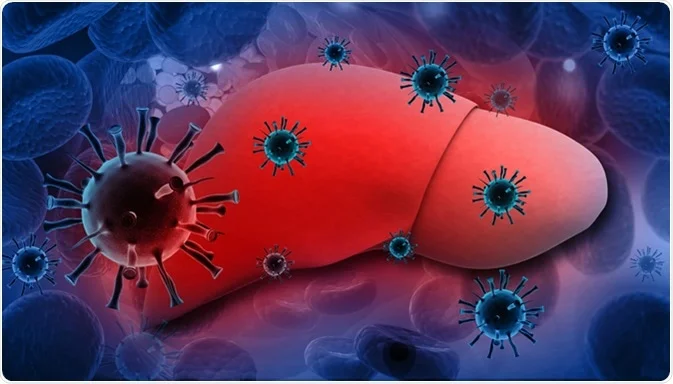
Hepatitis D Diagnosis and Treatment
Hepatitis D is a condition characterized by marked inflammation of liver. Hepatitis delta virus (HDV) was discovered in 1977 by Mario Rizzetto in Italy. Hepatitis D occurs in individuals who are already infected with the hepatitis B virus (HBV). The helper function required by HDV from HBV is hepatitis B surface antigen (HBsAg) synthesis. Hepatitis D is considered as the most severe form of viral hepatitis in humans.

Image Credit: Bluebay / Shutterstock
Diagnosis
Hepatitis D is spreading at a rapid pace even though HBV vaccination plans have existed for a long time. Therefore, it becomes essential to encourage all individuals with chronic hepatitis B (CHB) to be evaluated for HDV infection.
With the advent of a high number of cases in the immigrants coming from countries where hepatitis infections are endemic in nature, programs should be designed to give special attention to these individuals. Individuals at high-risk also include homosexual men, those who involve in sex with HDV-infected individuals, and patients undergoing hemodialysis or those who use injectable medications.
Hepatitis D can be diagnosed on the basis of medical history, physical examination, and blood tests.
Medical history: Physicians take the patient’s past and current medical history and look for symptoms and factors which can make the patient more susceptible to the infection.
Physical exam: During a physical examination, the doctor assesses the signs of liver damage such as changes in skin color, swelling in lower legs, feet, or ankles, and tenderness or swelling in the abdomen.
Blood test: A healthcare professional takes a blood sample from person and sends it to a laboratory to diagnose hepatitis D.
Hepatitis D should be taken into consideration in HBsAg positive individuals or those who have suffered from HBV infection recently. The diagnosis of hepatitis D infection is confirmed after serologic tests positive for the virus. HDV antigen is only briefly detectable in the serum. The detection of HDV antibodies (IgG or IgM anti-HDV) in HBsAg-positive patients is typically the first step in the diagnosis of HDV; though these antibodies can be falsely negative. Total anti-HDV antibodies can be identified with the help of radioimmunoassay (RIA) or enzyme immunoassay (EIA) kits.
HDV RNA viral load testing is also becoming an effective method to monitor ongoing HDV infection. For this, reverse transcriptase-polymerase chain reaction (RT-PCR) is used. RT-PCR is able to detect 10-100 copies of the HDV genome in the infected serum sample. Even though IgG and IgM antibodies vanish from the body in few weeks/months, post recovery, markers of chronic infection such as hepatitis D antigen and anti-HDV IgM and IgG antibodies remain in the blood stream.
Additional tests: If an individual has chronic hepatitis D, then liver damage can occur. Tests should be not only be done to confirm and find out the extent of liver damage, but also to rule out other causes of liver disease. These include blood tests, elastography (an ultrasound technique to measure the stiffness of liver), and liver biopsy. In liver biopsy, a needle is used to take a small piece of tissue from liver. A pathologist then examines the tissue under the microscope to look for signs of damage or disease.
In order to forecast the chances of development of hepatic problems in individuals with chronic HDV, a Baseline Event-Anticipation (BEA) score is used which takes into account patient demographics and other laboratory parameters such as bilirubin content and international normalized ratio (INR). The results of this instrument are able to pinpoint the variables related to poor prognosis.
Treatment
There are limited choices of treatment for HDV infection, and an accurate treatment is yet to be identified. Antivirals have shown little effect on the HDV infection. However, Pegylated interferon class of drugs have been found to be beneficial in most of the clinical studies.
Pegylated interferons should be given as weekly subcutaneous (SC) injections. The optimal treatment duration is not yet known, but treatment for 1 year is the most studied and used treatment duration. Combination treatments of pegylated interferons with antiviral and antiretroviral drugs have also been explored, but the results were not satisfactory, as the treatments did not show better viral response rates compared to interferon monotherapy.
Treatment with nucleoside/nucleotide analogs (NAs) is also being explored presently.
New Treatments in Chronic Hepatitis D
New compounds currently being explored for the management of CHD are hepatocyte entry inhibitors, farnesyl transferase inhibitors, nucleic acid polymers (NAPs), small interfering RNAs (siRNAs),and other immunological approaches (toll-like receptor agonists, checkpoint inhibitors, and hepatitis B virus vaccines).
With comprehensive screening of CHB patients for HDV, early diagnosis and consideration of treatment can be possible. However, due to an inadequacy of the current treatment options such as interferons, new approaches including prenylation inhibitors and blockers of liver cell entry are the need of the hour for CHD patients.
Sources
Further Reading
Last Updated: Aug 23, 2018






















.png)











No hay comentarios:
Publicar un comentario